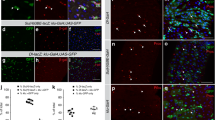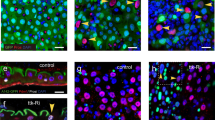Abstract
The intestinal tract maintains proper function by replacing aged cells with freshly produced cells that arise from a population of self-renewing intestinal stem cells (ISCs). In the mammalian intestine, ISC self renewal, amplification and differentiation take place along the crypt–villus axis, and are controlled by the Wnt and hedgehog (Hh) signalling pathways1. However, little is known about the mechanisms that specify ISCs within the developing intestinal epithelium, or about the signalling centres that help maintain them in their self-renewing stem cell state. Here we show that in adult Drosophila melanogaster, ISCs of the posterior intestine (hindgut) are confined to an anterior narrow segment, which we name the hindgut proliferation zone (HPZ). Within the HPZ, self renewal of ISCs, as well as subsequent proliferation and differentiation of ISC descendants, are controlled by locally emanating Wingless (Wg, a Drosophila Wnt homologue) and Hh signals. The anteriorly restricted expression of Wg in the HPZ acts as a niche signal that maintains cells in a slow-cycling, self-renewing mode. As cells divide and move posteriorly away from the Wg source, they enter a phase of rapid proliferation. During this phase, Hh signal is required for exiting the cell cycle and the onset of differentiation. The HPZ, with its characteristic proliferation dynamics and signalling properties, is set up during the embryonic phase and becomes active in the larva, where it generates all adult hindgut cells including ISCs. The mechanism and genetic control of cell renewal in the Drosophila HPZ exhibits a large degree of similarity with what is seen in the mammalian intestine. Our analysis of the Drosophila HPZ provides an insight into the specification and control of stem cells, highlighting the way in which the spatial pattern of signals that promote self renewal, growth and differentiation is set up within a genetically tractable model system.
This is a preview of subscription content, access via your institution
Access options
Subscribe to this journal
Receive 51 print issues and online access
$199.00 per year
only $3.90 per issue
Buy this article
- Purchase on Springer Link
- Instant access to full article PDF
Prices may be subject to local taxes which are calculated during checkout




Similar content being viewed by others
References
Crosnier, C., Stamataki, D. & Lewis, J. Organizing cell renewal in the intestine: stem cells, signals and combinatorial control. Nature Rev. Genet. 7, 349–359 (2006)
Micchelli, C. A. & Perrimon, N. Evidence that stem cells reside in the adult Drosophila midgut epithelium. Nature 439, 475–479 (2006)
Ohlstein, B. & Spradling, A. The adult Drosophila posterior midgut is maintained by pluripotent stem cells. Nature 439, 470–474 (2006)
Lee, T. & Luo, L. Mosaic analysis with a repressible cell marker (MARCM) for Drosophila neural development. Trends Neurosci. 24, 251–254 (2001)
Bach, E. A. et al. GFP reporters detect the activation of the Drosophila JAK/STAT pathway in vivo . Gene Expr. Patterns 7, 323–331 (2007)
Murakami, R., Takashima, S. & Hamaguchi, T. Developmental genetics of the Drosophila gut: specification of primordia, subdivision and overt-differentiation. Cell. Mol. Biol. 45, 661–676 (1999)
Lengyel, J. A. & Iwaki, D. D. It takes guts: the Drosophila hindgut as a model system for organogenesis. Dev. Biol. 243, 1–19 (2002)
Smith, A. V. & Orr-Weaver, T. L. The regulation of the cell cycle during Drosophila embryogenesis: the transition to polyteny. Development 112, 997–1008 (1991)
Robertson, C. W. The metamorphosis of Drosophila melanogaster, including an accurately timed account of the principal morphological changes. J. Morphol. 59, 351–399 (1936)
Korinek, V. et al. Depletion of epithelial stem-cell compartments in the small intestine of mice lacking Tcf-4. Nature Genet. 19, 379–383 (1998)
Pinto, D., Gregorieff, A., Begthel, H. & Clevers, H. Canonical Wnt signals are essential for homeostasis of the intestinal epithelium. Genes Dev. 17, 1709–1713 (2003)
Kuhnert, F. et al. Essential requirement for Wnt signaling in proliferation of adult small intestine and colon revealed by adenoviral expression of Dickkopf-1. Proc. Natl Acad. Sci. USA 101, 266–271 (2004)
van den Brink, G. R. et al. Indian Hedgehog is an antagonist of Wnt signaling in colonic epithelial cell differentiation. Nature Genet. 36, 277–282 (2004)
Madison, B. B. et al. Epithelial hedgehog signals pattern the intestinal crypt-villus axis. Development 132, 279–289 (2005)
Brand, A. H. & Perrimon, N. Targeted gene expression as a means of altering cell fates and generating dominant phenotypes. Development 118, 401–415 (1993)
McGuire, S. E., Le, P. T., Osborn, A. J., Matsumoto, K. & Davis, R. L. Spatiotemporal rescue of memory dysfunction in Drosophila . Science 302, 1765–1768 (2003)
van de Wetering, M. et al. Armadillo coactivates transcription driven by the product of the Drosophila segment polarity gene dTCF. Cell 88, 789–799 (1997)
Methot, N. & Basler, K. Hedgehog controls limb development by regulating the activities of distinct transcriptional activator and repressor forms of Cubitus interruptus. Cell 96, 819–831 (1999)
Ohlstein, B. & Spradling, A. Multipotent Drosophila intestinal stem cells specify daughter cell fates by differential notch signaling. Science 315, 988–992 (2007)
Gregorieff, A. et al. Expression pattern of Wnt signaling components in the adult intestine. Gastroenterology 129, 626–638 (2005)
Acknowledgements
We thank DSHB, NIG-Fly and Bloomington stock center for flies and antibodies. We also thank all members of the Hartenstein laboratory and Merriam laboratory for discussions. This work was supported by an NIH grant to J.R.M. and V.H.
Author Contributions S.T., J.R.M. and V.H. designed the project. The experiments were carried out by S.T., M.M. and A.Y.-H.
Author information
Authors and Affiliations
Corresponding author
Supplementary information
Supplementary Information 1
The file contains Supplementary Figures S1-S2 with Legends. (PDF 2963 kb)
Rights and permissions
About this article
Cite this article
Takashima, S., Mkrtchyan, M., Younossi-Hartenstein, A. et al. The behaviour of Drosophila adult hindgut stem cells is controlled by Wnt and Hh signalling. Nature 454, 651–655 (2008). https://doi.org/10.1038/nature07156
Received:
Accepted:
Published:
Issue Date:
DOI: https://doi.org/10.1038/nature07156
This article is cited by
-
The midgut epithelium of mosquitoes adjusts cell proliferation and endoreplication to respond to physiological challenges
BMC Biology (2024)
-
Drosophila melanogaster: a simple genetic model of kidney structure, function and disease
Nature Reviews Nephrology (2022)
-
A Summary of Planarian Signaling Pathway for Regenerative Medicine
Proceedings of the National Academy of Sciences, India Section B: Biological Sciences (2022)
-
Fused: a promising molecular target for an RNAi-based strategy to manage Bt resistance in Plutella xylostella (L.)
Journal of Pest Science (2022)
-
Emerging roles of the Hedgehog signalling pathway in inflammatory bowel disease
Cell Death Discovery (2021)
Comments
By submitting a comment you agree to abide by our Terms and Community Guidelines. If you find something abusive or that does not comply with our terms or guidelines please flag it as inappropriate.



